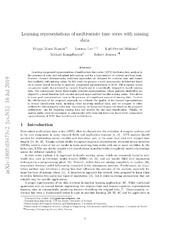Blar i forfatter "Livi, Lorenzo"
-
Critical echo state network dynamics by means of Fisher information maximization
Bianchi, Filippo Maria; Livi, Lorenzo; Jenssen, Robert; Alippi, Cesare (Chapter; Bokkapittel, 2017-07-03)The computational capability of an Echo State Network (ESN), expressed in terms of low prediction error and high short-term memory capacity, is maximized on the so-called “edge of criticality”. In this paper we present a novel, unsupervised approach to identify this edge and, accordingly, we determine hyperparameters configuration that maximize network performance. The proposed method is ... -
Data-driven detrending of nonstationary fractal time series with echo state networks
Maiorino, Enrico; Bianchi, Filippo Maria; Livi, Lorenzo; Rizzi, Antonello; Sadeghian, Alireza (Journal article; Tidsskriftartikkel, 2016-12-14)In this paper, we propose a novel data-driven approach for removing trends (detrending) from nonstationary, fractal and multifractal time series. We consider real-valued time series relative to measurements of an underlying dynamical system that evolves through time. We assume that such a dynamical process is predictable to a certain degree by means of a class of recurrent networks called Echo ... -
Deep divergence-based approach to clustering
Kampffmeyer, Michael C.; Løkse, Sigurd; Bianchi, Filippo Maria; Livi, Lorenzo; Salberg, Arnt Børre; Jenssen, Robert (Journal article; Tidsskriftartikkel; Peer reviewed, 2019-02-08)A promising direction in deep learning research consists in learning representations and simultaneously discovering cluster structure in unlabeled data by optimizing a discriminative loss function. As opposed to supervised deep learning, this line of research is in its infancy, and how to design and optimize suitable loss functions to train deep neural networks for clustering is still an open question. ... -
The deep kernelized autoencoder
Kampffmeyer, Michael C.; Løkse, Sigurd; Bianchi, Filippo Maria; Jenssen, Robert; Livi, Lorenzo (Journal article; Tidsskriftartikkel; Peer reviewed, 2018-07-18)Autoencoders learn data representations (codes) in such a way that the input is reproduced at the output of the network. However, it is not always clear what kind of properties of the input data need to be captured by the codes. Kernel machines have experienced great success by operating via inner-products in a theoretically well-defined reproducing kernel Hilbert space, hence capturing topological ... -
Deep kernelized autoencoders
Kampffmeyer, Michael C.; Løkse, Sigurd; Bianchi, Filippo Maria; Jenssen, Robert; Livi, Lorenzo (Peer reviewed; Book; Bokkapittel; Bok; Chapter, 2017-05-19)In this paper we introduce the deep kernelized autoencoder, a neural network model that allows an explicit approximation of (i) the mapping from an input space to an arbitrary, user-specified kernel space and (ii) the back-projection from such a kernel space to input space. The proposed method is based on traditional autoencoders and is trained through a new unsupervised loss function. ... -
Determination of the Edge of Criticality in Echo State Networks Through Fisher Information Maximization
Bianchi, Filippo Maria; Livi, Lorenzo; Alippi, Cesare (Journal article; Tidsskriftartikkel; Peer reviewed, 2017-03)It is a widely accepted fact that the computational capability of recurrent neural networks (RNNs) is maximized on the so-called “edge of criticality.” Once the network operates in this configuration, it performs efficiently on a specific application both in terms of: 1) low prediction error and 2) high shortterm memory capacity. Since the behavior of recurrent networks is strongly influenced by the ... -
Hierarchical Representation Learning in Graph Neural Networks with Node Decimation Pooling
Bianchi, Filippo Maria; Grattarola, Daniele; Livi, Lorenzo; Alippi, Cesare (Journal article; Tidsskriftartikkel; Peer reviewed, 2020-12-31)In graph neural networks (GNNs), pooling operators compute local summaries of input graphs to capture their global properties, and they are fundamental for building deep GNNs that learn hierarchical representations. In this work, we propose the Node Decimation Pooling (NDP), a pooling operator for GNNs that generates coarser graphs while preserving the overall graph topology. During training, the ... -
Learning representations of multivariate time series with missing data
Bianchi, Filippo Maria; Livi, Lorenzo; Mikalsen, Karl Øyvind; Kampffmeyer, Michael C.; Jenssen, Robert (Journal article; Tidsskriftartikkel; Peer reviewed, 2019-07-19)Learning compressed representations of multivariate time series (MTS) facilitates data analysis in the presence of noise and redundant information, and for a large number of variates and time steps. However, classical dimensionality reduction approaches are designed for vectorial data and cannot deal explicitly with missing values. In this work, we propose a novel autoencoder architecture based on ... -
Multiplex visibility graphs to investigate recurrent neural network dynamics
Bianchi, Filippo Maria; Livi, Lorenzo; Alippi, Cesare; Jenssen, Robert (Journal article; Tidsskriftartikkel; Peer reviewed, 2017-03-10)A recurrent neural network (RNN) is a universal approximator of dynamical systems, whose performance often depends on sensitive hyperparameters. Tuning them properly may be difficult and, typically, based on a trial-and-error approach. In this work, we adopt a graph-based framework to interpret and characterize internal dynamics of a class of RNNs called echo state networks (ESNs). We design principled ... -
Time Series Kernel Similarities for Predicting Paroxysmal Atrial Fibrillation from ECGs
Bianchi, Filippo Maria; Livi, Lorenzo; Ferrante, Alberto; Milosevic, Jelena; Miroslaw, Malek (Journal article; Tidsskriftartikkel, 2018)We tackle the problem of classifying Electrocardiography (ECG) signals with the aim of predicting the onset of Paroxysmal Atrial Fibrillation (PAF). Atrial fibrillation is the most common type of arrhythmia, but in many cases PAF episodes are asymptomatic. Therefore, in order to help diagnosing PAF, it is important to design procedures for detecting and, more importantly, predicting PAF episodes. ...


 English
English norsk
norsk








